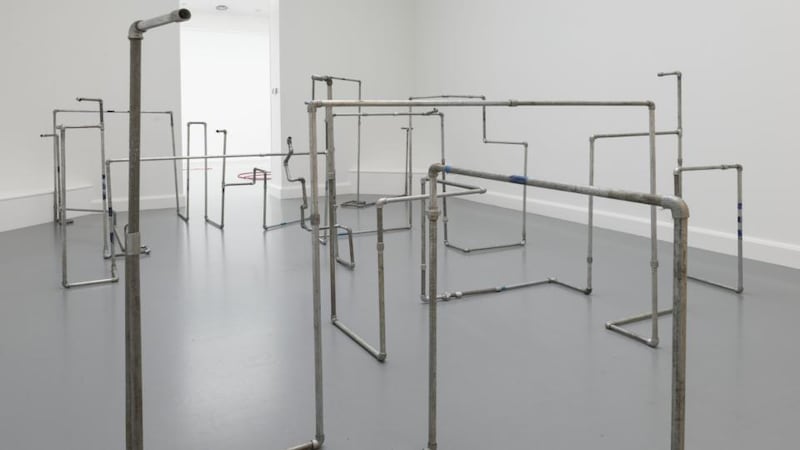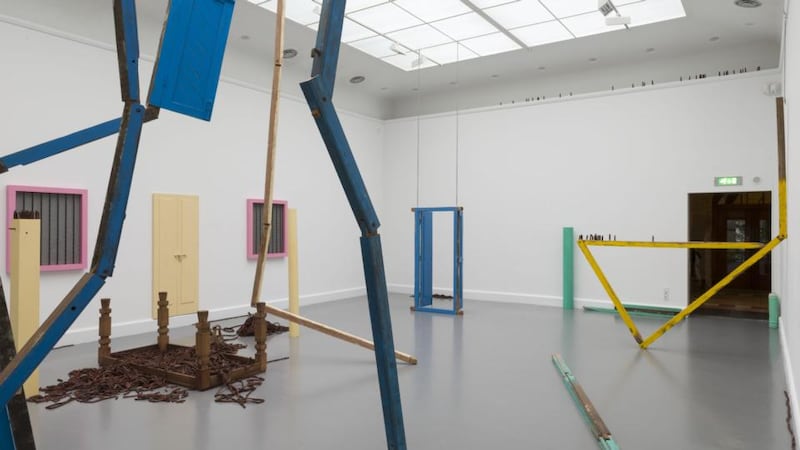She draws and paints beautifully, but Indian artist Sheela Gowda is more widely known for her use of unorthodox materials in her sculptural installations.
Those materials include dried cow dung, empty tar barrels, ash, tarpaulin, human hair, plumbing pipes and kumkum – an intensely coloured powder, widely used as a ritual marking in India, that is produced by mixing turmeric with slaked lime. All are in evidence in Open Eye Policy , a concise survey of her work from the early 1990s up to now, which is now on at the Irish Museum of Modern Art (Imma).
Gowda says she started out as a painter. Born in an industrial town in Karnataka, she studied painting in the state capital, Bangalore – where she now lives (although she is currently on a one-year residency in Berlin) – before making her way to the Royal College of Art in London in the mid-1980s. Among her artistic exemplars at the time were the pioneering Indian modernist KG Subramanyan and the contemporary artist Nalini Malani, whose dazzling paintings on glass were exhibited at Imma in 2007.


The erratic nature of development
About four years after the RCA and back in India, Gowda reckons she began to move away from the idea of figurative painting as a personal, expressive art form. This was substantially because of the turbulence around her: cultural shifts, insurgencies, riots, the erratic nature of modernisation and economic development. All of these contributed to a need to redefine assumptions and priorities.
She looked to some traditional materials and their functional uses, not out of nostalgia or Luddite sentiment, but as a means of articulating her sense of the world around her. On one level, her work since then can be seen as setting one image of India, as a modernising, powerhouse economy against another, pre-modern one, steeped in custom and tradition: high-tech industry versus manual labour. She is not taking sides, but pointing out the tensions that exist between these competing, sometimes mutually exclusive images.
One of the first large pieces in the show, A Blanket and the Sky , is a three-tiered rectangular construction dating from 2004. It is fashioned from used tar barrels. Gowda had noticed how road workers recycled the plentiful barrels to make temporary shelters, even temporary habitations. "I came across a colony of these improvised shelters and I thought, what an ingenious use of material."
They could flatten the barrels, join them together and shape them into right-angled corners. “The material determined the nature and size of the shelter. I was interested in imposing the same conditions on myself as an artist.”
In A Blanket and the Sky , she includes a blanket to lie on in the tar barrel shelter. At mid level she has cut and shaped the barrel metal into a miniature "origami" depiction of the colony. Look up and she's pierced the top with pinholes. It's uncannily like looking into a starry sky.
“I wanted to suggest another dimension, another universe,” she explains.
It is a simple but powerful work, specific in its sources but general in its implications, evoking ideas of labour, shelter, community and purpose. “I like the immediacy of the material to the viewer,” Gowda notes. There’s a sensual, pungent physicality to the tarry, reworked metal. While it is shaped into a monolithic form, like a minimalist sculpture or a modernist building, it stubbornly retains a rough-hewn character. “It’s an imperfect material that doesn’t quite translate into the perfection of geometry.” One feels that Gowda’s view of contemporary India, and perhaps the wider contemporary world, is contained in that phrase.
Working with cow dung
She doesn't see her work in terms of a before and an after: a painter turned installation artist. "I was always interested in the way the figure interacts with the background in painting. When I began to use cow dung, I used it as a kind of painting medium, in washes."
Then she painted rudimentary marks on to flattened discs of dung, and eventually it became a more sculptural material for her. “It wasn’t a break, more as if the painting expanded into the room.”
Ubiquitous and used as a manure, a fuel and as an ingredient in mud bricks, cow dung is, for Gowda, usefully symbolic as "an everyday substance packed with energy". At the same time, as with an Irish artist using, say, turf, she is wary of her employment of it "becoming exotic elsewhere". She is not interested in being exotically Indian. Sharp Eye Policy could be an alternative title for her exhibition, because she uses her skills to interrogate images with admirable ruthlessness.
Protest My Son , centring on a billboard- sized reproduction of an appropriated newspaper image that depicts a tribal demonstration, is a case in point. Follow the logic of her work and you realise it is in part a critique of the protesters who are, she suggests, acting out a drama of contrived tribal identity. The knee-jerk reaction is, she points out: "I'm privileged, they're downtrodden." In fact they are playing on easy preconceptions of them as being "other".
What’s going on, she elaborates, is more nuanced. There are layers to the story that are invisible. One such layer she hints at by including a fake tiger claw – a very lucrative and highly sophisticated trade. Again, she is not being moralistic: “They do what they have to do to survive.” But, she points out, to pity them is to doubt their intelligence, to patronise them. Instead, she encourages us to unpack the complexities of this image – and of all images.
Open Eye Policy
is at Imma until
June 22.
imma.ie


















